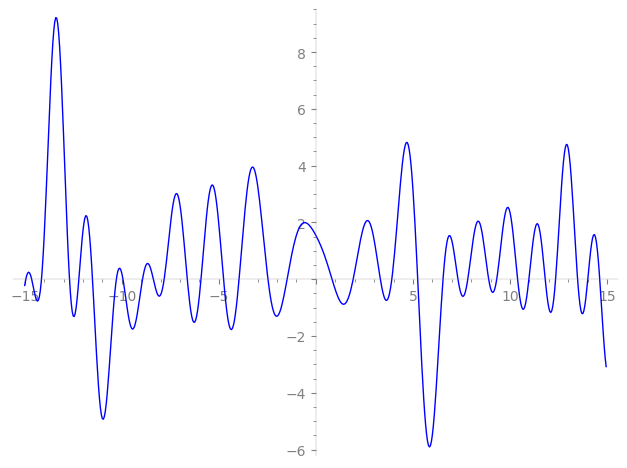| L(s) = 1 | + (−0.866 + 0.5i)2-s + (0.866 + 0.5i)3-s + (0.499 − 0.866i)4-s + (−0.270 − 0.468i)5-s − 0.999·6-s + (1.40 + 2.23i)7-s + 0.999i·8-s + (0.499 + 0.866i)9-s + (0.468 + 0.270i)10-s + (4.02 + 2.32i)11-s + (0.866 − 0.499i)12-s − 1.33·13-s + (−2.34 − 1.23i)14-s − 0.540i·15-s + (−0.5 − 0.866i)16-s + (5.45 + 3.14i)17-s + ⋯ |
| L(s) = 1 | + (−0.612 + 0.353i)2-s + (0.499 + 0.288i)3-s + (0.249 − 0.433i)4-s + (−0.120 − 0.209i)5-s − 0.408·6-s + (0.532 + 0.846i)7-s + 0.353i·8-s + (0.166 + 0.288i)9-s + (0.147 + 0.0854i)10-s + (1.21 + 0.699i)11-s + (0.249 − 0.144i)12-s − 0.369·13-s + (−0.625 − 0.329i)14-s − 0.139i·15-s + (−0.125 − 0.216i)16-s + (1.32 + 0.763i)17-s + ⋯ |
\[\begin{aligned}\Lambda(s)=\mathstrut & 1218 ^{s/2} \, \Gamma_{\C}(s) \, L(s)\cr =\mathstrut & (0.00828 - 0.999i)\, \overline{\Lambda}(2-s) \end{aligned}\]
\[\begin{aligned}\Lambda(s)=\mathstrut & 1218 ^{s/2} \, \Gamma_{\C}(s+1/2) \, L(s)\cr =\mathstrut & (0.00828 - 0.999i)\, \overline{\Lambda}(1-s) \end{aligned}\]
Particular Values
| \(L(1)\) |
\(\approx\) |
\(1.540626025\) |
| \(L(\frac12)\) |
\(\approx\) |
\(1.540626025\) |
| \(L(\frac{3}{2})\) |
|
not available |
| \(L(1)\) |
|
not available |
\(L(s) = \displaystyle \prod_{p} F_p(p^{-s})^{-1} \)
| $p$ | $F_p(T)$ |
|---|
| bad | 2 | \( 1 + (0.866 - 0.5i)T \) |
| 3 | \( 1 + (-0.866 - 0.5i)T \) |
| 7 | \( 1 + (-1.40 - 2.23i)T \) |
| 29 | \( 1 + (2.76 + 4.61i)T \) |
| good | 5 | \( 1 + (0.270 + 0.468i)T + (-2.5 + 4.33i)T^{2} \) |
| 11 | \( 1 + (-4.02 - 2.32i)T + (5.5 + 9.52i)T^{2} \) |
| 13 | \( 1 + 1.33T + 13T^{2} \) |
| 17 | \( 1 + (-5.45 - 3.14i)T + (8.5 + 14.7i)T^{2} \) |
| 19 | \( 1 + (4.85 - 2.80i)T + (9.5 - 16.4i)T^{2} \) |
| 23 | \( 1 + (2.69 + 4.66i)T + (-11.5 + 19.9i)T^{2} \) |
| 31 | \( 1 + (-3.18 - 1.83i)T + (15.5 + 26.8i)T^{2} \) |
| 37 | \( 1 + (5.48 - 3.16i)T + (18.5 - 32.0i)T^{2} \) |
| 41 | \( 1 - 2.50iT - 41T^{2} \) |
| 43 | \( 1 - 10.6iT - 43T^{2} \) |
| 47 | \( 1 + (-5.06 + 2.92i)T + (23.5 - 40.7i)T^{2} \) |
| 53 | \( 1 + (-3.13 + 5.42i)T + (-26.5 - 45.8i)T^{2} \) |
| 59 | \( 1 + (4.01 - 6.95i)T + (-29.5 - 51.0i)T^{2} \) |
| 61 | \( 1 + (-3.12 + 1.80i)T + (30.5 - 52.8i)T^{2} \) |
| 67 | \( 1 + (5.21 - 9.03i)T + (-33.5 - 58.0i)T^{2} \) |
| 71 | \( 1 - 6.17T + 71T^{2} \) |
| 73 | \( 1 + (-10.2 - 5.92i)T + (36.5 + 63.2i)T^{2} \) |
| 79 | \( 1 + (12.9 - 7.47i)T + (39.5 - 68.4i)T^{2} \) |
| 83 | \( 1 - 8.67T + 83T^{2} \) |
| 89 | \( 1 + (-13.7 + 7.95i)T + (44.5 - 77.0i)T^{2} \) |
| 97 | \( 1 + 13.8iT - 97T^{2} \) |
| show more | |
| show less | |
\(L(s) = \displaystyle\prod_p \ \prod_{j=1}^{2} (1 - \alpha_{j,p}\, p^{-s})^{-1}\)
Imaginary part of the first few zeros on the critical line
−9.938064084060830179163197663484, −8.929023111062628273946025604236, −8.373362511012473348951949798717, −7.81571476392477783332646665830, −6.62524624185110622488737441845, −5.91840524710394115184293778058, −4.75713346413726959938229373782, −3.95831394201472595060945847207, −2.46949056581830937563301732936, −1.48327107573679468003419132740,
0.829442297005214094658543890059, 1.91966457448185698330416743388, 3.31921390189128423391038044347, 3.90993305295948656365094394138, 5.24316602572160403899284282111, 6.54871657278822315409640539221, 7.31794944870113338972231034652, 7.82371055191634577885359389296, 8.899554806152276514372385615060, 9.314101539748038835551069602256

